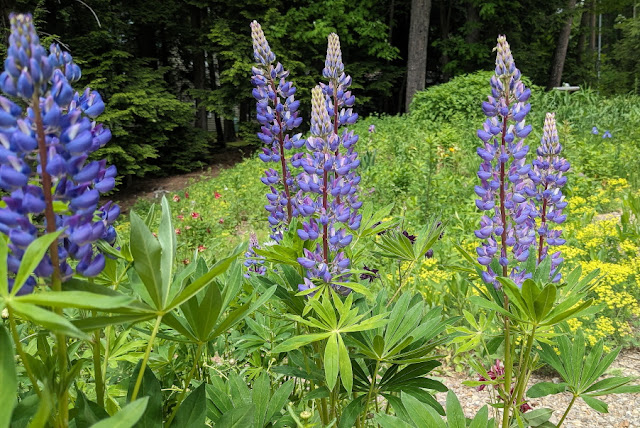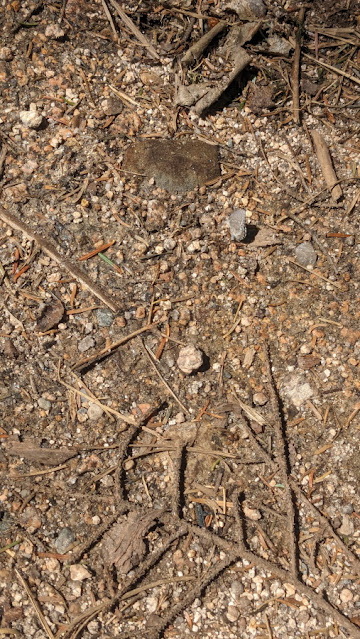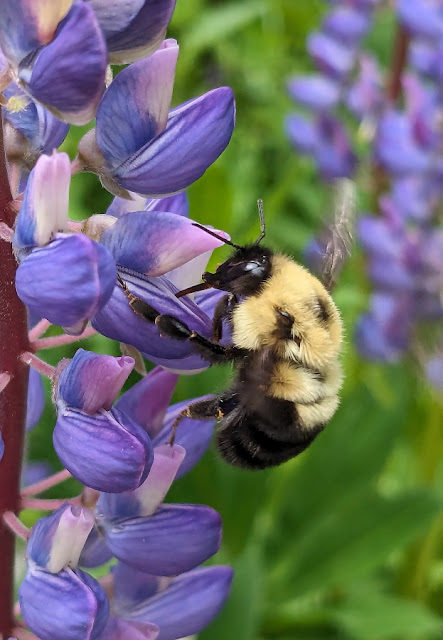I'm sorry to report that it wasn't a good week for birds on Lake Wicwas, at least the ground nesting birds. Tuesday morning the LPC loon biologist came to the lake for his first survey of the season, and our first stop was to check on the loon nest. One loon was out at the expected sentry location guarding the cove, but as the nest came into view we saw the other loon was off the nest, some 20 or 30 yards away - not what we'd expect. We paddled in closer to the nest and the loon didn't seem at all concerned. When we got close enough to see the nest, the reason was clear. Both eggs had been destroyed. One was pretty broken up and a couple feet out of the nest, the other more intact and in the nest. The biologist collected the shells for study, and we left saddened, to continue our survey.
a.JPG) |
| The empty nest. Perhaps they can determine what occurred by studying the eggs. |
As we approached the middle of the lake, right at the dividing line between the two nesting territories, we saw five more loons acting in an aggressive manner, and yet another farther away by the entrance to the usual south nesting site. That meant eight loons on the lake.
We watched them tangle with each other for a while before we moved on. By the time we finished the full lake survey and were nearing home again, we found seven of the loons had congregated together, and none of them were happy.
 |
| Seven loons together is an unusual sight in June. |
They were head-dunking and diving and wing-rowing after each other. I wondered if these non-resident loons had any role in destroying the eggs, though predators seem more likely - a racoon, mink, eagle, or even a bear. It seems like a loon's four inch beak might scare off a racoon or a mink, but who knows. The good news is that it's still plenty early enough for a second nest attempt, and the next day all the visiting loons were nowhere to be seen. We can hope things will settle down and the two resident pairs will get back to business.
I found the other sad sight when I went to to see if the eggs in the Hermit Thrush nest I discovered a couple of weeks ago had hatched. As well as I thought the nest was hidden, some animal had found it, dragged it out from under its hemlock cover, predated the nest, and surely consumed the eggs.
 |
| Remnants of the Hermit Thrush nest. |
It can be hard to watch nature sometimes, but it's all part of the food chain. Hermit Thrushes may have two broods a summer anyway, so there's a good chance it will re-nest also.
I'll report on one more carnivorous animal, and this may be hard for some people to watch, so be warned.
 |
| A dragonfly and its prey. |
This dragonfly was dining upon some other flying insect right on our deck. In the past I've shown the pretty ferocious looking mouth parts of a a dragonfly, and now I've seen what they can do.
It was sucking out all the juices from its prey's body, and when it was done there were just wings and legs left behind. This is a blurry video, but it shows meal time in action:
Gruesome I know, sorry, but again, that's life in the wild.
How about something prettier now?
 |
| June is the time for Lupines. |
 |
| And bumble bees. |
This bumble bee was flitting all around Linda's Lupines. Its proboscis seems ideally suited to probe into the tiny slit in each flower to extract nectar.
We haven't been up to Sugar Hill this year, but I think now is the time to see the lupines at their peak. Don't forget to stop in to Polly's Pancake House!
I spent a beautiful day in the White Mountains this week with a good friend as we hiked up to Lonesome Lake in Franconia Notch.
 |
| Mt. Lafayette rises above Lonesome Lake. |
The season there is a couple of weeks behind the Lakes Region as shown by the dozens of Painted Trillium we saw along the trail. Right near the lake there were also some neat little butterflies. When they flew they were bright blue, but as soon as they landed they folded their wings and just about disappeared as they blended into the ground.
 |
| Well hidden when not in flight. |
 |
| But it's there. |
This is a Spring Azure butterfly, one of the first to emerge, but there were also lots of Tiger Swallowtails flitting all around the lake.
Now here's a really interesting find that a nature-watching friend sent me:
 |
| Wool Sower Gall. Photo by Dick Hunnewell. |
I'd never seen anything like this before, but a little digging turned up that it's another kind of gall, this one a Wool Sower Gall. Like other galls, it's the nursery of an insect larva, in this case, the Wool Sower Gall Wasp. After the adult wasp inserts an egg into a leaf or stem, the host tree creates the gall around it to isolate the intrusion, and in the process builds a sanctuary for the larva to develop in, well protected from predators. This wasp will only lay its eggs on White Oak, so I'll have to look for these trees on my next excursion. You can read more about his particular wasp and gall here. Thanks for sharing this Dick!
We've had good stretch of some really nice weather, and with the long days it's been great growing season. On a bike ride up in the Chemung area I saw the farmers out harvesting their first cutting of hay; it's good to see agricultural fields here among all our forests.
Another piece of good news: One of my favorite photographers is back at the lake, and already sending me great pictures. She heard a new bird right after she returned, and spent quite a while working to find it and get a picture. It's a Blackburnian Warbler, a species that seems to be everywhere this year, though I've rarely seen or heard it before. She has more patience than it do, as these birds are very elusive!
 |
| Blackburnian Warbler. Photo by Debby Crowell. |
Great to have you back Debby!
(P.S. Did you notice the brown pine needles? You can read what's going on here)




Scott…great read this rainy morning….loved the close up of the dragonfly…t
ReplyDeleteVery nice photos.
ReplyDelete